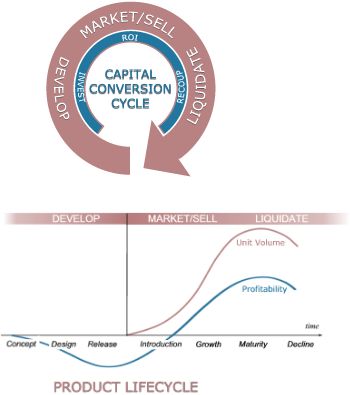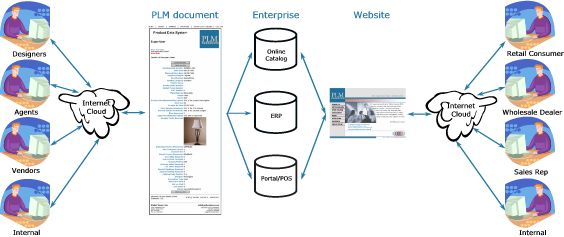THE ACCESSORIES MARKET
 |
|
"We realized
that Uttermost needed a cost-effective, real-time alternative that
would link our partners together across time zone and business
cultures".
|
- Mac Cooper
President of The Uttermost Company
|
In the world of furniture accessories - wall décor, mirrors, lighting, tabletop
art, etc. - new product is the lifeblood of a company's existence. "Our retailers
need fresh and new accessories to keep their stores and associated furniture
interesting", explains Mac Cooper, President of The Uttermost Company
- an industry leader in wall décor and portable lighting. "However,
if it takes nine months to deliver those designs to market, much of the opportunity
is lost due to the accessory market's increasingly shorter product lifecycles".
THE CHALLENGE
Furthermore, many in the furniture/accessories world rely upon an outsourced
manufacturing model - often on a global basis - to provide more value and
product diversity to their consumers, adding yet another layer of complexity
to their efforts. And therein lies the rub: How do midsize manufacturers
maintain their creative edge, leverage a globally distributed value chain[i] and
still deliver often hundreds of new SKU's promptly to market?
DELIVERING CREATIVITY
Product development typically involves a number of designers, suppliers,
manufacturers and internal personnel all engaged in a cycle of iterative
sketches, reviews, samples and revisions until the design(s) are "just
right". But
let's face it; getting the design right is only part of the challenge. When
the dust settles, when the design reviews are complete, and the sample is "tossed
over the wall" into production, all of the "qualitative" design
vocabulary needs to be translated into a set of "quantitative" product
attributes - various dimensions, CAD drawings, photographs, vendor numbers,
etc. - in order for production plans [read delivery] to be met. This latter
effort, which falls under the heading of Product Lifecycle Management (PLM),
is becoming increasingly more important to the Accessories Industry
as product lifecycles shrink in the face of global competition. Bluntly stated,
the speed in which an organization can bring new products to market (accelerated
time-to-market) is becoming THE competitive metric in the new millennium.
 PLM DEFINED PLM DEFINED
At its heart, PLM is based upon document
control throughout the product’s entire life
as a means of accelerating time-to-market.
When Product Design was conducted
in-house at one or two geographic locations sharing product information [read
collaboration] was relatively simple. Today,
product conception, design reviews, sourcing, launch strategy and manufacturing
rarely occur in the same location… or time zone… or country. Global competition,
favorable overseas manufacturing opportunities, and the overwhelming success
of outsourcing as a business model have stretched Design across borders,
cultures and value chain partners.
PLM promotes value chain collaboration by providing a centralized document
repository – “the same sheet music” – from which design information can be
shared. Commissioned designers can upload sketches, CAD and concepts; Agents
can respond with prototype images, dimensions and weights; Vendors can offer
component suggestions and design alternatives; Internal personnel can review
material lists to ensure long lead time items are in process; Logistics
can assign customs numbers; Quality Assurance can ensure labeling, hazardous
materials, and assembly instruction are uploaded and attached to the design. Design
comments and price negotiations can be recorded to ensure “a paper trail
of accountability” follow the product from conception through to delivery. In
short, the velocity of information between design stakeholders increases,
resulting in accelerated time-to-market.
AD HOC DATA MANAGEMENT
While the Fortune 500 can afford the PLM systems necessary
to achieve accelerated time-to-market, small and midsize enterprises (SME),
regrettably, have had to rely upon ad hoc systems and procedures to harness
their information flows. Typically, these systems are nothing more than a
flurry of email, faxed correspondence and phone calls attempting to tabulate
data - either in paper form or within an Excel ® spreadsheet - in preparation
for production. Unfortunately, these ad hoc systems usually run into three
BIG problems:
 |
|
"PLM allows us to focus upon the product design rather than product administration.".
|
- David Gebhart
President of Global Views
|
- Inadequate visibility - up-to-date development status is extremely difficult to determine;
- synchronization - it's difficult to keep all "stakeholders" informed
when changes occur;
- Lack of collaboration - sharing information on a real time basis is impossible.
Although ad hoc data management systems are flawed in their execution, their
motivation and intent are still well founded in an organization's
attempt to accelerate time-to-market. It therefore behooves the SME to recognize
these shortcomings and address them as quickly and efficiently as is possible. To
do so they must understand the phases of a product's lifecycle, the general
data requirements of the stakeholders during the Development phase, and the
limitations an organization's current "legacy" information technology
(IT) systems have in managing these.
LEGACY IT SYSTEMS
Nearly every company has some sort of Enterprise Resource Planning (ERP)
system that codifies and coordinates Production. Unfortunately, Development
with its iterative, trial-and-error methodology does not follow the linear
path of ERP and production. As such, Development has had to rely upon information
collected at the department level incumbent to their functional roles - Marketing
manages price, promotion, and distribution information; Design manages color,
size, shape attributes; Finance manages standard costs, and so on.
The flaw in these ad hoc systems usually surfaces during the run up to Market
or a catalog shoot”, states David Gebhart, President of Global Views, Inc.
– a leader in decorative home accessories, “when all the iterations of product
information – dimensions, photos, samples, delivery status – need to be compiled
and coordinated in one place by deadline”. Because ad hoc systems lack
inter-departmental visibility and synchronization, the outcome usually results
in a last minute frenetic attempt to “collaborate-or-die”.
DISSECTING PRODUCT LIFECYCLES
Operations has traditionally characterized product lifecycles in terms of
their production life - Introduction, Growth, Maturity and Decline. It is
this "production" framework that has fostered and defined the ERP
software that harnesses an organization's internal human, financial and manufacturing
assets.

Management, on the other hand, characterizes product lifecycles in a more
encompassing way: working capital conversion cycle. Over the life of the product, working
capital is invested in new designs in hopes of a Return on Investment (ROI)
during the subsequent production phases. Toward the end of the product’s
life, excess raw material and finished goods need to be liquidated to free
up capital for the next iteration of product lifecycles.
 According to consulting firm Pittiglio Rabin Todd & McGrath
approximately 80% of a product’s cost structure is determined during the
development phase of its lifecycle. Paradoxically, this is one area that
management has had little visibility and control. Distributing design stakeholders
around the globe exacerbates an already challenging situation. According to consulting firm Pittiglio Rabin Todd & McGrath
approximately 80% of a product’s cost structure is determined during the
development phase of its lifecycle. Paradoxically, this is one area that
management has had little visibility and control. Distributing design stakeholders
around the globe exacerbates an already challenging situation.
Why is Development so difficult to manage? Unlike production information
that concerns itself with internally generated accounting, planning, and
procurement information, development information often originates outside
the walls of the enterprise. CAD drawings, samples, images and sketches emanate
from a cadre of outsourced design, manufacturing, sourcing and logistics
services. These "external" stakeholders participate heavily during
Development, and therefore, the exchange of development information becomes
intense. Unfortunately, such interaction has historically flown under the
radar scan of enterprises control systems: “That which cannot be measured,
cannot be managed”.
DATA ATTRIBUTES OF PRODUCT DEVELOPMENT
Contrary to the ERP driven Production environments, Development has fundamentally
different information requirements:
- Data Vaulting - Facilitating
the storage and disposition of design data;
- Workflow Control - Managing
and overseeing the design/review/approval process;
- Versioning - Codifying design
iterations and providing "role-back" to prior designs;
- Venue - a secure area where
designs can be shared simultaneously, often in real time.
The sophistication and cost of PLM systems that track/store this kind of
information is directly proportional to the product’s level of engineering
complexity. Highly engineered products (electronics, aviation) rely heavily
upon all four information aspects and can cost several hundreds of thousands
of dollars. Products of lower engineering complexity (such as accessories)
cost substantially less.
ENTER THE INTERNET
The ubiquity and low cost of the World Wide Web has [finally] brought the
concepts of PLM into the realm of the small and midsize enterprises. While
in the past, data networks consisted of expensive leased line communication,
today’s Internet offers global communication for as little as the cost of
an AOL account. Yesterday’s expensive computing hardware has given way to
low cost personal computers. Proprietary communication protocols have fallen
to IP protocols secured by Virtual Private Networking (VPN) and encrypted
transmission (SSL). In short, the Internet offers all the ingredients necessary
for PLM.
PLM - THE WHOLE ENCHILADA
Obviously, the benefits to Development within the Accessories Industry are
clear, however, that’s just the beginning. As stated earlier the basis of
PLM is founded upon document control throughout the entire product
lifecycle. This holistic view that PLM provides, enables the enterprise
to leverage product data forward into Production and other sell-side applications. Unbeknownst
to the Designers, Agents, Marketing, QA and Logistic stakeholders who fervently
enter and maintain product design data is the resulting catalog of SKUs,
images, item and UPC numbers… replete with accurate, up-to-date attributes
that can be syndicated out to ERP item masters, on-line catalogs/websites,
showroom floors POS and Customer Service portals. In fact, PLM can even
coordinate liquidation via traditional and web based
outlets.

CONCLUSION
Combined with the ubiquity and low cost of the Internet, PLM concepts –
once available to only the elite few – are now permeating down into the value
chains of traditional industries. The accessories industry, which has characteristically
lagged in the deployment of technology, is ripe for PLM. Overseas manufacturing
coupled with increasingly short product lifecycles and prolific product introduction
places tremendous strain on the accessories manufacturer as they struggle
to maintain their competitive stance within an evolving industry.
With its holistic view, PLM now becomes the repository for ALL product
data which in turn can be syndicated out to other mission critical applications
such as ERP, showroom Point of Sales (POS), websites and portals. In short,
PLM keeps everyone within the value chain – from concept to consumer - singing
from the same sheet music.
PLMresearch makes every reasonable effort to present the
most reliable information available, however, it offers no specific guarantee
regarding the accuracy or completeness of the information presented. PLMresearch
is not a registered investment advisor, and it is not the intent of this
document to recommend specific companies for investment, acquisition,
or other financial considerations.
If you have questions or comments concerning this document
please contact us at 1-800-310-3992 or info@PLMresearch.com. See
us on the web at http://www.PLMresearch.com
PLMresearch
PO Box 1354
Plymouth, MA 02362
[i] The idea of the value chain is based
on the process view of organizations, the idea of seeing a manufacturing
(or service) organization as a system, made up of subsystems or external
suppliers. See Porter, Michael E., "Competitive Advantage". 1985,
Ch. 1, pp 11-15. The Free Press. New York.
|
